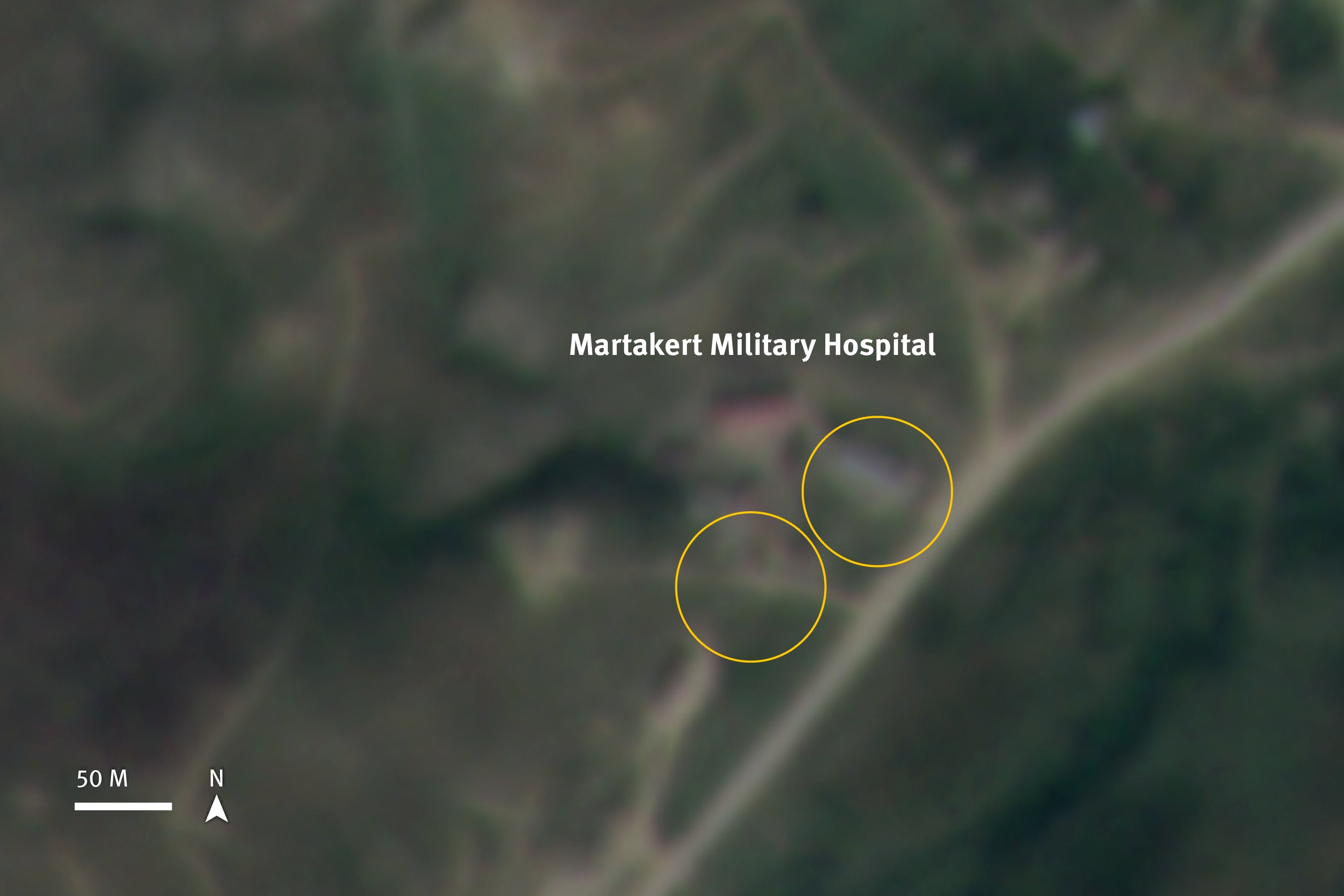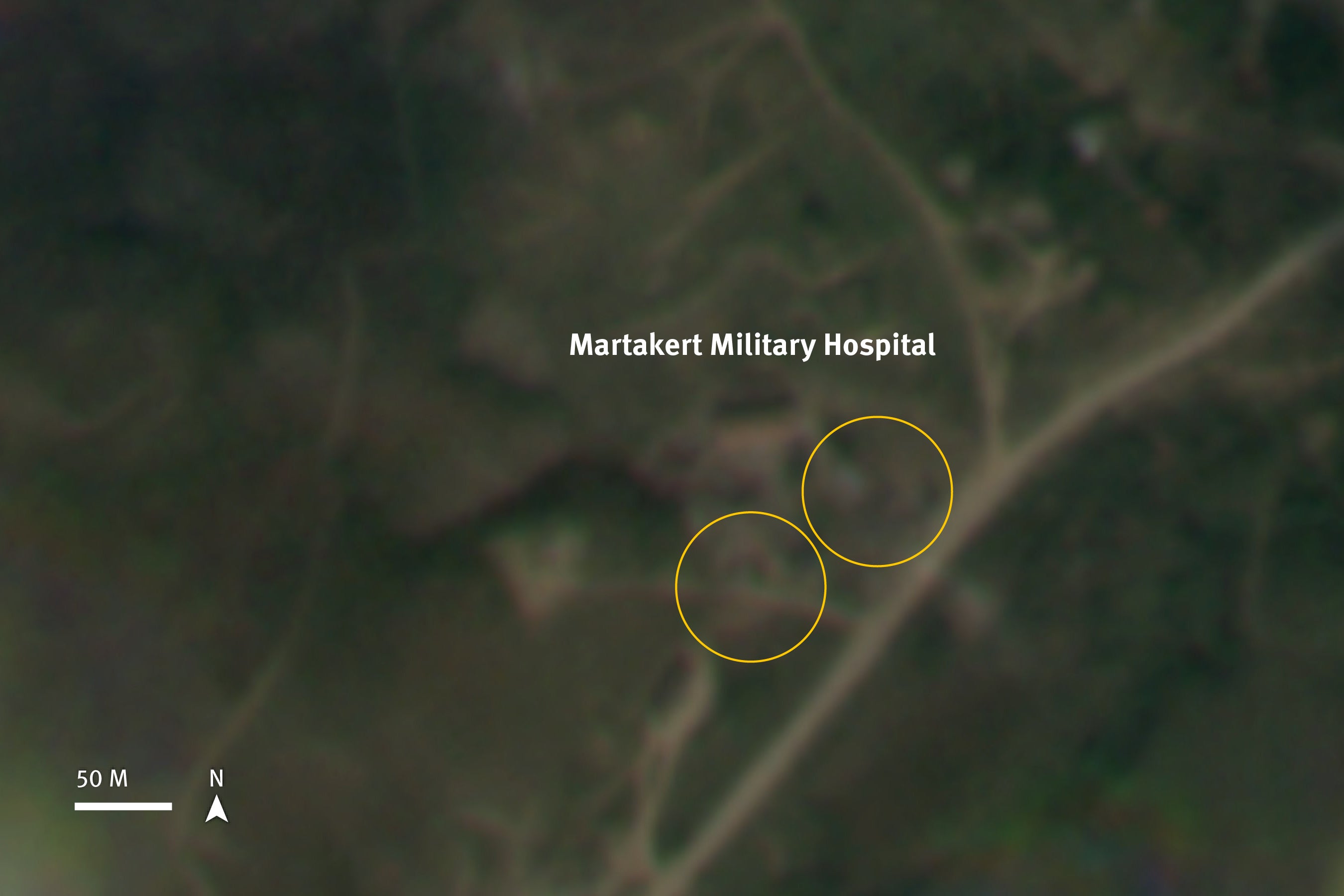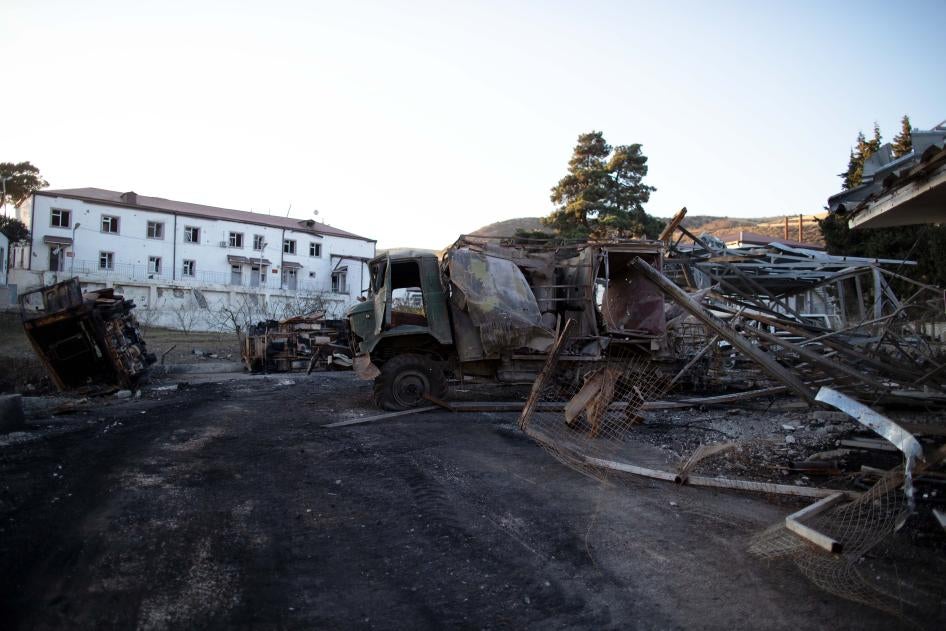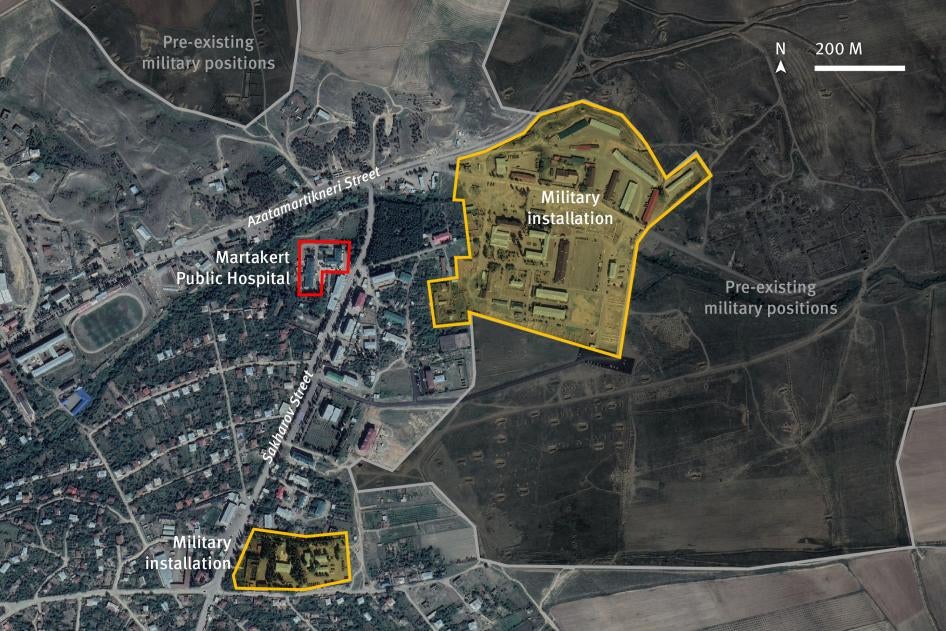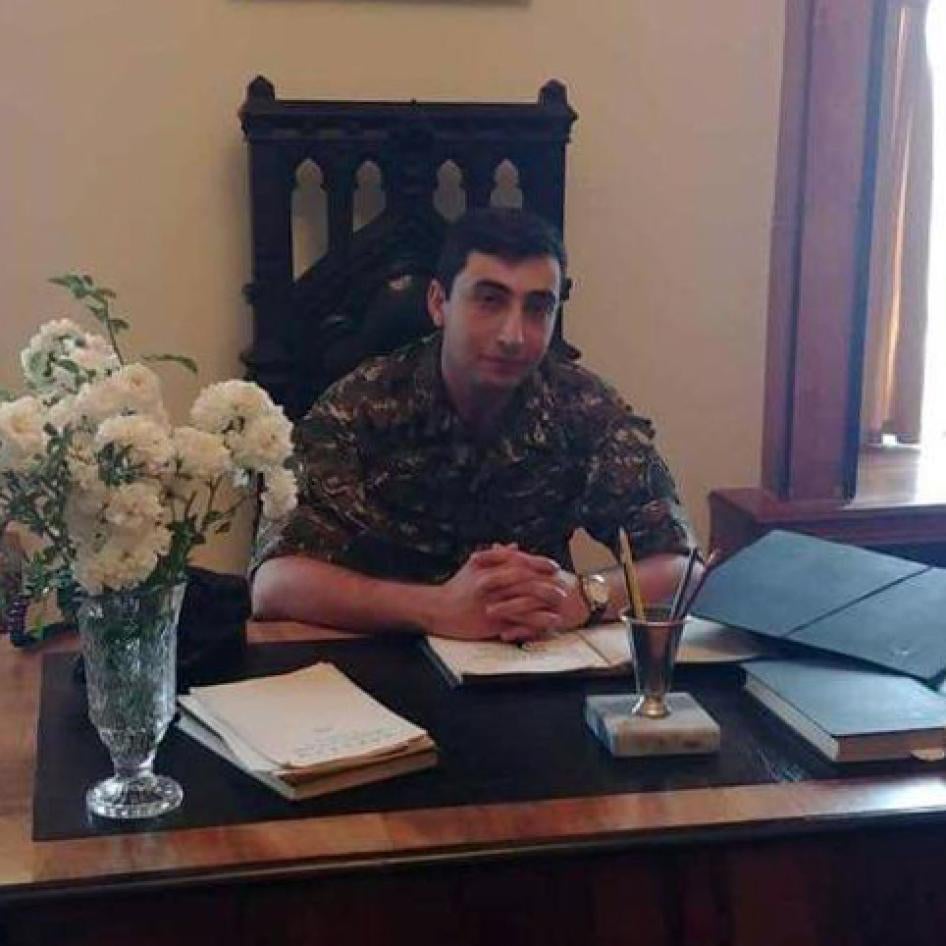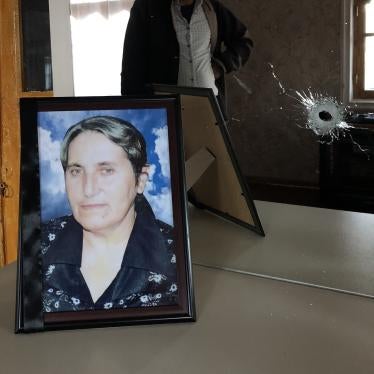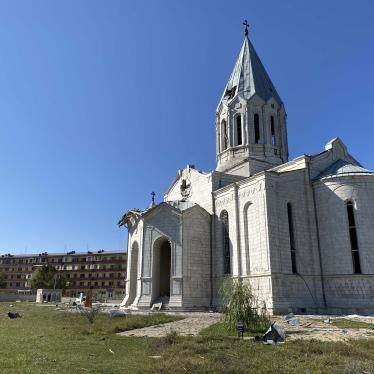Three unlawful attacks on medical facilities by Azerbaijani forces during the six-week armed conflict in Nagorno-Karabakh have come to light in recent Human Rights Watch research in the region.
Human Rights Watch documented multiple unlawful strikes on a public hospital in Martakert in September through November 2020, and an unlawful strike on a military hospital in the town’s outskirts in October. The hospitals were very close to the front lines at the time.
The weapon used by Azerbaijani forces against the military hospital – a satellite-guided variant of an Israeli-supplied rocket artillery system called LAR-160 – suggests that the strike was intentional. The strikes on the public hospital, including with Grad rockets and cluster munitions, appeared indiscriminate.
The attacks damaged both hospitals and impeded medical work, but no one was wounded or killed in the attacks.
On-site observations, analysis of videos, most of which were on social media, and satellite imagery analysis enabled Human Rights Watch to identify numerous legitimate military targets in Martakert, some of them close to the two hospitals. By locating military facilities, equipment, or personnel inside the city, and near the two hospitals, Nagorno-Karabakh and Armenian authorities endangered civilians and put medical workers and their patients at risk.
Human Rights Watch also documented a deliberate attack on September 28, apparently by Azerbaijani forces, on an Armenian military ambulance, in which assailants shot and killed a military doctor.
Human Rights Watch previously documented damage to two hospitals in Stepanakert, (also referred to as Khankendi in Azerbaijan), the capital city of Nagorno-Karabakh, due to Azerbaijan’s indiscriminate strikes in October, and documented damage to a health clinic in the Azerbaijani city of Barda, in an indiscriminate attack by Armenian forces.
Medical facilities and personnel are civilian objects with special protections under the laws of war. They include hospitals, clinics, medical centers, and ambulances and other medical transportation, whether military or civilian. Parties to a conflict are obligated to ensure that they do not endanger or harm medical personnel, and do not attack or damage hospitals and ambulances.
The analysis of these unlawful attacks is not intended to be a comprehensive account of all damage to medical facilities during the armed conflict. The Azerbaijani government alleged, as of October 13, that six medical facilities had been damaged. Armenian authorities told Human Watch that at least nine medical facilities were damaged in Stepanakert, and in the Martakert, Martuni, and Askeran districts of Nagorno-Karabakh.
Possible Targeted Attack on Martakert Military Hospital
Azerbaijani rocket artillery hit a military hospital in Aghabekalanj, a village just southwest of Martakert city, along the main road, in an apparently deliberate strike on October 14, 2020.
Before being hit, the hospital had been providing first aid to the wounded – as many as 130 a day, hospital staff told Human Rights Watch – some of whom were then transported to Stepanakert for further treatment.
The nearest military installation is 1.5 kilometers to the south, along the main road. Satellite imagery taken on October 8 shows that one of the installation’s buildings had been hit, damaging its roof. The satellite imagery also shows military positions that pre-date the outbreak of hostilities, fewer than 350 meters southwest of the hospital. Earthen berms are also visible about 150 meters north of the hospital.
As Azerbaijani forces frequently shelled Martakert and surrounding areas during the conflict, patients were treated in the two-story hospital’s reinforced basement, where medical staff also slept.
Human Rights Watch visited the hospital in November and found that the attack had caused significant damage. A small structure by the gate was largely destroyed, and the medical workers’ housing in the back was severely damaged. The outer walls of the main building showed blast and fragmentation damage, and the windows were shattered.
In the yard, there were remnants of several burned vehicles, too charred to identify. The staff said that most were military ambulances.
Sasha Baghiryan, a 63-year-old hospital maintenance worker, and Hayk Aghajanyan, a 20-year-old military serviceman who had been assigned to the hospital to help carry the wounded and run errands for medical workers, said the attack took place between 4:00 and 4:30 p.m. Satellite imagery shows that the attack took place between 11:48 a.m. local time, on October 14, and 11:54 a.m. local time, on October 15. At the time of the attack, both men were in the basement, where medical workers were performing surgery on three wounded servicemen.
Baghiryan and Aghajanyan said that they heard four separate explosions as the rockets hit one after the other. Aghajanyan showed Human Rights Watch four impact craters: two in the yard close to the fence, several meters apart; one on the road near the gate; and one outside the rear of the hospital, near the medical workers’ housing. Human Rights Watch found numerous munition fragments at the impact sites.
An examination of the impact sites, weapon remnants, and the proximity of the four points of impact suggest that the strike was carried out by the satellite-guided variant of an Israeli-supplied rocket artillery system called LAR-160, using EXTRA rockets. The Stockholm International Peace Research Institute lists the transfer of LAR-160 launchers and EXTRA rockets from Israel to Azerbaijan in 2005-2006. An EXTRA rocket is equipped with a unitary warhead containing 120 kilograms of explosives, and its manufacturer claims that accuracy of less than 10-meters (circular-error-probable) can be achieved by the rocket’s satellite guidance capability.
In light of the preexisting military positions that were about 350 meters from the hospital, and the constant, heavy shelling of the area near the hospital, the October 14 strike may have been indiscriminate. However, the accuracy of the LAR-160 gives a basis to conclude that the strike may have been deliberate.
The hospital roof was not marked with a red cross to signify that it was a medical facility, but the then-ombudsperson for Nagorno-Karabakh told Human Rights Watch that the facility was well known as a hospital, had never been used for any other purposes, and that the International Committee of the Red Cross had the hospital’s coordinates. The front of the admissions building was marked with a large Bowl of Hygieia, a cup with a snake, a pharmacy and medical symbol. According to hospital staff, ambulances were coming and going around the clock.
A hospital staff member showed Human Rights Watch a small, one-story building about 100 meters behind the hospital, which he said had served as a warehouse for landmines. He said that “all the landmines were picked up by the military and moved elsewhere when the fighting began in September.” The warehouse as such likely represented a legitimate military target, and by storing landmines so close to the hospital Armenian forces put the hospital, its staff, and patients at risk. However, the warehouse was empty at the time of the attack and there were no military positions on the hospital grounds, the staff member said.
Indiscriminate Strikes on Martakert Public Hospital
Martakert’s public hospital, the R. Bazyan District Medical Association, is on the northern end of Sakharov Street, which suffered extensive shelling damage during the six-week war.
At the southern end of Sakharov Street, 800 meters from the hospital, there is a military installation, with military positions and military vehicles. A local resident said that he and his battalion were based there throughout the hostilities. When a Human Rights Watch researcher examined the site in November, it had been clearly damaged by shelling.
Another military installation that, as of October 8, had visible activity, is about 250 meters from the hospital. A satellite image taken at 11:54 a.m. local time on September 27, 2020, shows new damage to at least five buildings on the north edge of this base, indicating that the site was struck several times hours after the hostilities began.
Dozens of military positions and earthen berms, which were there before the start of hostilities on September 27, some as close as 350 meters from the hospital, are visible on satellite imagery. These positions are especially concentrated in the eastern part of the town and oriented in the direction of the line of contact. As of October 8, there were large vehicles at some of these positions, suggesting that they may have been in use.
A video recorded on October 6 that credible local sources gave Human Rights Watch shows military personnel and a transport vehicle driving along Sakharov Street, approximately 100 meters south of the hospital entrance.
Due to intense shelling in the area from the first day of hostilities, on October 4 the hospital staff were evacuated to a village some thirty km away and the hospital became a military medical triage center for wounded Armenian forces.
A hospital custodian who regularly checked the facilities after the civilian evacuation said the hospital was hit several times on various days during the six weeks of fighting.
In the October 8 satellite imagery, several impact craters are also visible in the immediate vicinity of the military installation that is 250 meters from the hospital. The October 6 video also shows a large impact crater on the main road, approximately 210 meters west of the hospital.
Three witnesses said most of the damage to the hospital was inflicted on November 9, when shelling in the area was particularly heavy. Satellite imagery shows that the military installation 250 meters from the hospital was also struck sometime between the early afternoon on November 9 and the morning of November 10.
Human Rights Watch visited the hospital on November 24 and noted significant blast and fragmentation damage to the hospital and the adjacent outpatient clinic. Numerous munition fragments were seen at impact sites in the hospital yard, in particular fragments of Grads and cluster munitions carried by LAR-160 rockets. A staff surgeon at the hospital, Dr. Tigran Arzumanyan, and a staff pediatrician, Dr. Khachatur Melikyan, said that the hospital’s roof was also damaged in several places.
The two doctors said that when the shelling began on September 27, staff moved all 39 patients, including children and mothers with newborn babies, to the basement. Those whose health allowed it were discharged that day, and the rest were promptly evacuated to Stepanakert, 46 kilometers away.
They said that during the first day of hostilities the hospital also provided first aid to 80 wounded military servicemen, 78 of them with fragmentation wounds, and several wounded civilians.
“We lost electricity, so we had to use flashlights while working on the wounded,” said Dr. Melikyan. “When the first munition landed here, it was such a big bang that the tiles in the basement flew up.”
Several days into the hostilities, the hospital staff were evacuated to Chdlran village, where they worked as a triage brigade for the wounded.
Due to the sheer number of strikes on the hospital, Human Rights Watch was not in a position to match particular strikes with specific damage. But neither of the explosive weapons that Azerbaijani forces used in these strikes – Grads and cluster munitions – can be targeted with enough accuracy to have avoided damaging civilian structures in the area.
Explosive weapons with wide-area effects may have a large destructive radius, be inherently inaccurate, or deliver multiple munitions at the same time, causing high civilian loss if used in populated areas. Often a single weapon will fall into two of these categories.
Grads are unguided rockets that cannot be targeted accurately and are often fired in salvos from multi-barrel rocket launchers to saturate a wide area. Based on the examination of the fragments and the impact points, Human Rights Watch concluded that Azerbaijani forces used “enhanced fragmentation” Grads, which have a layer of steel spheres imbedded between the explosive substance and the skin of the rocket to maximize casualty-producing effect.
Grad rockets cannot be targeted with sufficient precision to differentiate military targets, which may be attacked, from civilians and civilian structures, such as homes and schools not being used for military purposes, which are protected from attack. So, their use in populated areas violates the laws-of-war prohibition against indiscriminate attacks.
Cluster munitions, in this case carried by LAR-160 rockets – Human Rights Watch found two rocket bodies in the yard, close to one of the impact points – are an inherently indiscriminate weapon banned by an international treaty. They typically open in the air, dispersing multiple bomblets or submunitions over a wide area, putting anyone in the area at the time of attack, whether combatants or civilians, at risk of death or injury. Many of the submunitions do not explode on contact, but remain armed, becoming de facto landmines.
Locations contaminated by unexploded submunitions remain dangerous until the remnants are cleared and destroyed. Both Azerbaijan and Armenia used them extensively during the six-week conflict. Use of cluster munitions shows blatant disregard for civilian life and both countries should join the Convention on Cluster Munitions, which bans them, ratified by 110 countries. They should also make an immediate commitment not to use indiscriminate weapons, like Grads, in populated areas.
Deliberate Attack on a Military Ambulance
On September 28, a group of five apparent Azerbaijani servicemen attacked an ambulance on the road in Kalbajar district of Azerbaijan, killing a military doctor, Sasha Rustamyan, 26, and injuring the driver and the accompanying Armenian army sergeant.
At the time, Kalbajar district, now under Azerbaijani control, was still held by Armenian forces. The driver, 26, and the sergeant, 41, interviewed separately, said that the attack took place between 1 and 2 p.m. by the Omar mountain pass, which is very close to the then-line of contact. The ambulance was heading to pick up the wounded at a frontline position, and the sergeant rode in the ambulance to provide directions.
Suddenly, they saw five servicemen, in fatigues and armed with assault rifles, possibly a patrol, blocking the road. The ambulance stopped some 25 to 30 meters away. Dr. Rustamyan jumped out, apparently intending to speak to the servicemen, but they opened fire on the vehicle.
“[Dr. Rustamyan] must have thought they were our [forces]… and then everything happened so quickly,” said the sergeant. Dr. Rustamyan’s relatives showed Human Rights Watch his death certificate stating that he had died of multiple bullet wounds. He was a recent graduate of the Armenian State Medical University.
“The windshield was riddled with bullets,” the driver said. He recalled touching his head and feeling blood on his hand. He executed a protective maneuver by putting the car in reverse, and then turning it over on its left side, by a gorge. He saw Dr. Rustamyan turning back towards the ambulance. Ten meters away from it, he was shot in the back and fell to the ground. “I knew he was dead,” the driver said. “I pushed what remained of the windshield out with my hand, crawled out, shut my eyes, then threw myself into the gorge… While I was rolling down, I heard an explosion.”
The sergeant, who received a lower arm bullet wound, said that he crawled out of the back door of the vehicle. He also rolled into the gorge, stopping on a flat spot a few meters below. From there he saw the servicemen approach the vehicle, search it, and then blow it up. When they left, the sergeant crawled back up and walked some four kilometers until he saw an Armenian military truck. Вased on his directions, the military also found the driver. Another group of soldiers picked up Dr. Rustamyan’s body later that day.
The driver, diagnosed with a concussion and mild injuries, and severe shock spent a month in a hospital recovering. The sergeant was at a hospital undergoing treatment for his arm wound when Human Rights Watch interviewed him in December.
The ambulance was a regular UAZ-3962 medical service vehicle. Although painted khaki, it cannot be confused with any other type of military vehicle because of the prominent red-cross markings, including just above the windshield, and the “medical service” sign on the side. At the time of the attack, the driver, the sergeant, and the doctor were dressed in Armenian military fatigues, but the doctor wore a medical insignia on his sleeve. The driver had an assault rifle, which the doctor held while riding but left in the vehicle when he got out of the car to speak to the gunmen.
Carrying firearms for self-defense does not constitute an act “harmful to the enemy,” and the vehicle retains its status as a medical unit.
Neither the driver nor the sergeant could see identifying insignia on the fatigues of the servicemen nor heard them speak. The overall context strongly suggests that the attackers were Azerbaijani forces.
Ambulances have protected status under international humanitarian law, and the presence of military servicemen and firearms in an ambulance does not remove the protection unless there are grounds to suggest that it is being used for purposes harmful to the enemy, such as conveying soldiers to the front line or carrying out attacks. There is no evidence to suggest either was the case on September 28.
The servicemen on the road should have taken all feasible precautions to ensure that the vehicle and its occupants were valid military targets before carrying out an attack. The attack on the marked ambulance and the subsequent killing of Dr. Rustamyan appear to have been carried out deliberately and may constitute a war crime.
